Below are the steps I used to assemble the rev. A
CNC buffer board:
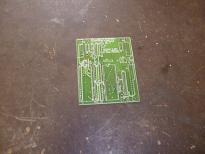
|
The bare board looks as follows:
|
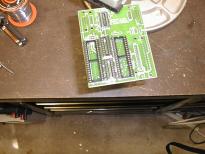
|
Next, I solder in the IC sockets.
|

|
Then I added in the various 2×3, 2×5 and
2×13 .1" male headers.
|
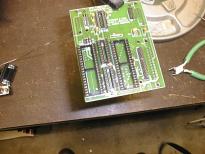
|
Next, I soldered in the capacitors and the
10K pull up resistor. Note that C12 has the
+ lead of the capacitor pointing down. All the
other tantalum capacitors have the + lead pointing
up.
|

|
Finally, the 3 D connectors are soldered in.
The total amount of time spent attaching the
components to the board was 20 minutes.
|
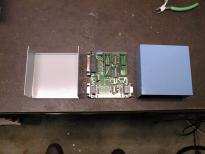
|
I found a box that was just barely big enough for
the board.
|

|
Most of my mounting holes did not work with this
box since they were too close to the board edge.
So I added a mounting on a empty section of
real estate.
|
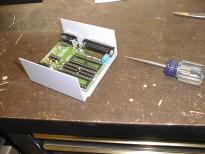
|
I installed 3 spacers on the bottom of the board
and placed it into the box.
|
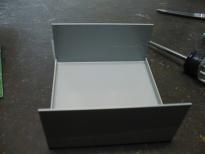
|
Using a sharp pointy object I scratched the outlines
of the D connectors on the inside of the box.
|
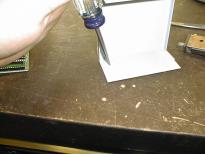
|
Using a sharp pointy object and a hammer like object,
I marked to dimples for where the starter hole needed
to be drilled. Afterwards, I flip the box over and
invert the dimples using the pointing object and hammer
like object.
|
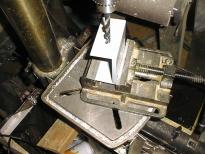
|
The next set of pictures are a little confusing.
If first tried to drill the large pilot hole in
one step. The drill wandered all over the place.
|
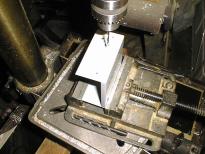
|
So, I changed to a smaller drill and drilled two
pilot holes. Then I went back to the larger drill
and made the holes bigger. The requirement here is
to have a hole big enough for the nibbler tool.
(By the way, I do not think I managed to get a
picture of the nibbler tool in action.)
|

|
The resulting holes for the nibber tool are shown.
|
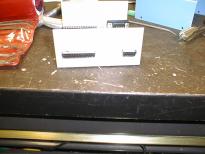
|
Using the nibbler tool, the initl slots are nibbled
out. They are too small, so I use a whole bunch of
metal files to file the larger. This takes a very
long time (at least half an hour.)
|
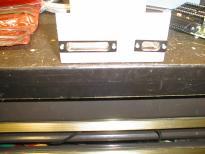
|
Eventually, I take the metal D connector covers off the
PCB and I can press fit them into the holes. Note,
that these are female connectors and the holes will
eventuall have to be enlarged even more to be big
enough for the male connctors.
|
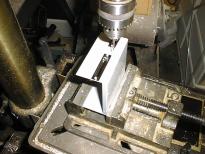
|
Using the press fit D connector covers, I first drill
four small holes for the D connector screw mounts.
|
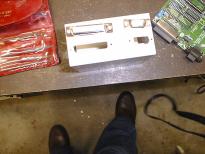
|
You can see the small holes on either side. Unfortunately,
the holes need to be unlarged so that the screw mounts
can slide right through.
|

|
So, an even larger hole is drilled where the pilot
holes were drilled.
|

|
You can see the much larger holes on each side of
the D connector holes.
|
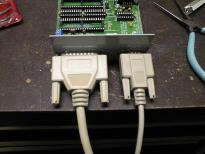
|
Now there is even more filing to get a couple of male
connectors to fit into the D connector holes.
As usual, the filing takes a bunch of time --
say 15-20 minutes.
|

|
Ad finally the the connectos fith though the holes.
|
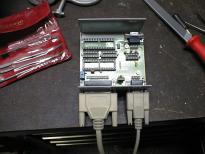
|
Now the board is place in and a little more filing
is performed until the male conectors firmly attach
to the female connectos on the board. Yeah.
|

|
This is what it all looks like. If you look closely
you can see there is a gap around both of the D
connectors.
|

|
There should be a few more pictures here, but I guess
I just forgot. Using the PCB as a template, I drilled
3 holes on the bottom of the box to mount the PCB to.
|
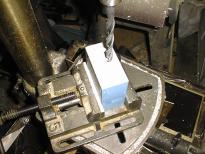
|
I drilled a power jack hole onto the other side of
the box.
|

|
It is .5" in diameter -- the largest twist drill I have.
|

|
Finally, the power jack is mounted. It looks kind of
stupid sticking out like that, but it is fully functional.
|

|
Finally, board is screwed onto the bottom of the box
with 3 #4-40 screws. It is not going any where.
|
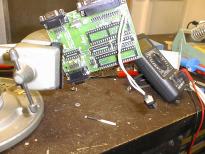
|
The power jack is soldered to a couple of wires
and heat shrink tubing is attached.
|
That is about it.




























